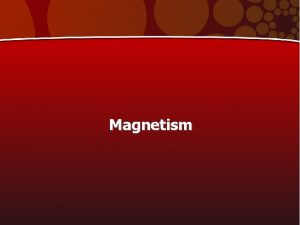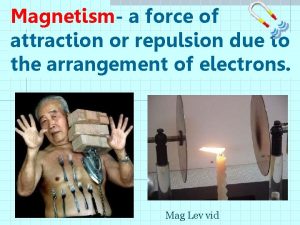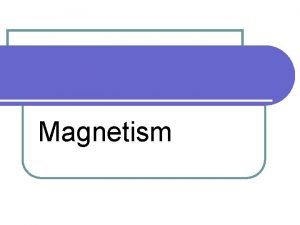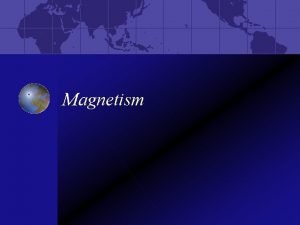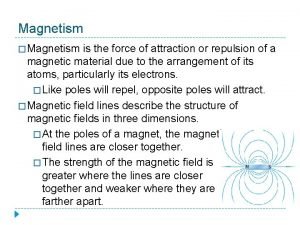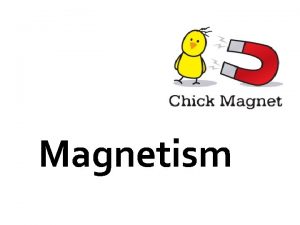Magnetism attraction or repulsion that acts at a








- Slides: 8

Magnetism attraction or ______ repulsion that acts at a Magnetism is a force of ______ distance and is due to a _______ field. magnetic moving Magnetic fields are caused by _______ electrically charged particles. Magnetic Field Just like electric fields, magnetic fields are arrows represented by _____. north Magnetic fields originate on _________ and terminate on _______ poles south poles _____. Unlike electric charges, magnetic poles cannot isolated be ______.

Magnetic field around a current carrying wire moving Magnetic fields are caused by _______ electrically charged particles. Thus any wire carrying ________ will induce a current magnetic ____ field _____ around the wire. The shape of the magnetic field concentric _____. circles is ______ Magnitude of the magnetic field around a current carrying wire µo I B= 2 r Where: B = magnetic field strength (Tesla) µo = 4π x 10 -7 T. m/A I = current (amperes) r = distance from the wire (meters)

Direction of the magnetic field around a current carrying wire Right Hand Rule I Thumb - points in direction of conventional current Fingers - encompass the wire in the direction of the magnetic field * The Right-Hand Rules apply to positive charges or positive (conventional) current

Forces on moving charges external magnetic When a charge is placed in an ______ ____, that charge will experience a ______ field magnetic _____ force if two conditions are met. 1) the charge is moving relative to the magnetic field, 2) the charge's velocity has a component perpendicular to the direction of the magnetic field Magnitude of the force on a moving electric charge F = qv. B Where: F = magnetic Force (N) q = electric charge (C) v = velocity of charge (m/s) B = EXTERNAL magnetic field (T)

Magnitude of the force on a current-carrying wire F = Il B Where: F = magnetic Force (N) I = current (A) l= wire length (m) B = EXTERNAL magnetic field (T) Direction of the force on a moving charge or a currentcarrying wire Right Hand Rule II Thumb - points in direction of conventional current Fingers - points in the direction of the external magnetic field Palm - points in the direction of the force I

Practice RHR I (a) P Direction of B field? I (b) B Direction of B field at point P? out of the page I (c) (d) Will wires attract or repel? attract I I P The field at point P is into the page, what direction is the current?

Practice RHR II X X X X B N X X X X In what direction is the proton deflected? out of the page X X X X The wire is pulled down, which way is current induced? left O O O O O O O O O O O B O O O Which direction will the wire move? left S B - In what direction is the electron deflected? out of the page +

B Try this X X X X In what direction is the charge initially forced when entering the field? right X X X X What happens to X X X X mv r= q. B the path of the charge as it moves through the field? It curves - Where: v = velocity of charge (m/s) r = radius of curved path (meters) q = charge (C) m = mass of charge (kg) B = EXTERNAL magnetic field (T)









